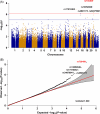Exome-wide association analysis identifies novel risk loci for alcohol-associated hepatitis
- PMID: 39058584
- PMCID: PMC11902603
- DOI: 10.1097/HEP.0000000000001027
Exome-wide association analysis identifies novel risk loci for alcohol-associated hepatitis
Abstract
Background and aims: Alcohol-associated hepatitis (AH) is a clinically severe, acute disease that afflicts only a fraction of patients with alcohol use disorder. Genomic studies of alcohol-associated cirrhosis (AC) have identified several genes of large effect, but the genetic and environmental factors that lead to AH and AC, and their degree of genetic overlap, remain largely unknown. This study aims to identify genes and genetic variations that contribute to the development of AH.
Approach and results: Exome-sequencing of patients with AH (N=784) and heavy drinking controls (N=951) identified an exome-wide significant association for AH at patalin-like phospholipase domain containing 3, as previously observed for AC in genome-wide association study, although with a much lower effect size. Single nucleotide polymorphisms (SNPs) of large effect size at inducible T cell costimulatory ligand ( ICOSLG ) (Chr 21) and TOX4/RAB2B (Chr 14) were also exome-wide significant. ICOSLG encodes a co-stimulatory signal for T-cell proliferation and cytokine secretion and induces B-cell proliferation and differentiation. TOX high mobility group box family member 4 ( TOX4 ) was previously implicated in diabetes and immune system function. Other genes previously implicated in AC did not strongly contribute to AH, and the only prominently implicated (but not exome-wide significant) gene overlapping with alcohol use disorder was alcohol dehydrogenase 1B ( ADH1B ). Polygenic signals for AH were observed in both common and rare variant analysis and identified genes with roles associated with inflammation.
Conclusions: This study has identified 2 new genes of high effect size with a previously unknown contribution to alcohol-associated liver disease and highlights both the overlap in etiology between liver diseases and the unique origins of AH.
Conflict of interest statement
Ramon Bataller consults for GlaxoSmithKline and Nov Nordisk. He is on the speakers’ bureau for AbbVie, Boehringer Ingelheim, and Gilead. Suthat Liangpunsakul consults for Durect, Korro Bio, and Surrozen. The remaining authors have no conflicts to report.
Figures



References
-
- SAMHSA, Center for Behavioral Health Statistics and Quality . 2022 National Survey on Drug Use and Health. Alcohol use disorder in past year: among people aged 12 or older; by age group and demographic characteristics, numbers in thousands, 2021 and 2022.
MeSH terms
Grants and funding
- U01 AA026264/AA/NIAAA NIH HHS/United States
- U01 AA026938/AA/NIAAA NIH HHS/United States
- Z99 AA999999/ImNIH/Intramural NIH HHS/United States
- UH2 AA026903/AA/NIAAA NIH HHS/United States
- R01 AA030312/AA/NIAAA NIH HHS/United States
- I01 CX000361/CX/CSRD VA/United States
- P50 AA024333/AA/NIAAA NIH HHS/United States
- U01 AA026975/AA/NIAAA NIH HHS/United States
- U01 AA026972/AA/NIAAA NIH HHS/United States
- U01 AA026917/AA/NIAAA NIH HHS/United States
- ZIA AA000130/ImNIH/Intramural NIH HHS/United States
- Z01 AA000466/ImNIH/Intramural NIH HHS/United States
- U01 AA026817/AA/NIAAA NIH HHS/United States
LinkOut - more resources
Full Text Sources
Research Materials
Miscellaneous

